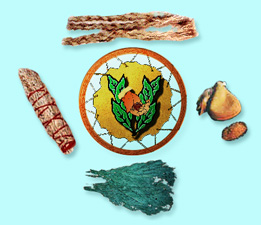|
NOTICE:
GEOCITIES IS CLOSING!
Find us at our new home at:
www.redroadcollective.bravehost.com
The four sacred plants are gift of the Four Manido (Spirits of the Four Directions). To those who live in the traditional way, there are four plants which are especially revered and used in daily living. The creator taught us to use the natural herbs of sage, sweetgrass, tobacco, and cedar smoke as a physical reminder to them of this omnipotent presence. It is the sacred way.
Tobacco (Semah)
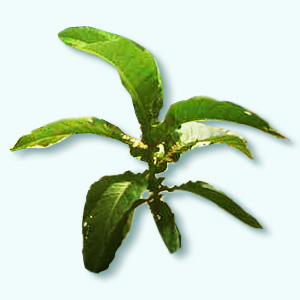 Semah, or tobacco, is one of the four sacred plants. It represents the Eastern Direction and the mind. The Anishinaabe use a form of tobacco known as kinikinik, or a red willow mix. Because it opens the door to the creator, When tobacco is used to make smoke, it is one of the most sacred of plants for Native people. Some elders say that tobacco is used to connect the worlds since the plant�s roots go deep into the earth, and its smoke rises high into the sky. This plant is highly respected and highly honoured. Giving tobacco is a beautiful way of our people. Ceremonies using tobacco invoke a relationship with the energies of the universe, and ultimately the Creator, and the bond made between earthly and spiritual realms is not to be broken. Semah, or tobacco, is one of the four sacred plants. It represents the Eastern Direction and the mind. The Anishinaabe use a form of tobacco known as kinikinik, or a red willow mix. Because it opens the door to the creator, When tobacco is used to make smoke, it is one of the most sacred of plants for Native people. Some elders say that tobacco is used to connect the worlds since the plant�s roots go deep into the earth, and its smoke rises high into the sky. This plant is highly respected and highly honoured. Giving tobacco is a beautiful way of our people. Ceremonies using tobacco invoke a relationship with the energies of the universe, and ultimately the Creator, and the bond made between earthly and spiritual realms is not to be broken.
There are four traditional Tobacco uses. None of them will harm you.
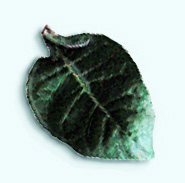 Prayer Prayer
When we put sacred tobacco into our Sacred Pipes, we are also using that tobacco as a communicator to the sky world where all of our ancestors have gone on before us. We do not inhale the sacred smoke that comes from the pipe. When the smoke rises, it is taking our prayers with it up to the Creator and all of our relatives who have gone on before us. Our elders show us that when we finish with prayers, we sprinkle a small amount of tobacco on the drum. This is a way of giving back to and thanking the Creator for all he has given to us. Tobacco can be used on a daily basis as each new day is greeted with prayers of thankfulness. Many elders say to hold it in your prayers of thankfulness. They also add that you are to hold it in your left hand as this is the hand closer to your heart.
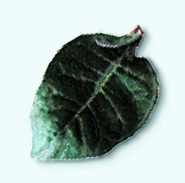 Offerings Offerings
Traditionals burn tobacco before storms. It is used to pray that powerful storms won�t hurt our families. To pray with tobacco in your Native language is very powerful. It can make a difference in the physical world.
 Purification Purification
Tobacco is used in the offering of prayer to the Creator, acting as a medium for communication. It is either offered to the fire, so the smoke can lift the prayers to the Creator, or it is set on the ground in a nice, clean place. It means we come humbly to our creator. We proclaim our innocence. When you want to speak to the creator, we are told to make an offering of the tobacco plant. An Elder will take tobacco ties and offer them to the fire or offer it back to Mother Earth on behalf of the Sacred Circle. Anishinabe people live life in a very sacred manner. When taking something from the Earth, they always explain to the spirit of the plant why it is being done and offer some tobacco in return for the generosity and help of the plant which shared itself so freely.
Purification and working with a clear mind and heart are essential in asking the land to provide for people. This is keeping with the Native belief that if you do things in a good way, good things will follow. If careful attention is not established, the result will not be as good. Sometimes elders place tobacco on the water. This shows our thanks to the Creator, for the lifeblood of our Mother the earth that is provided to us. At this time we also acknowledge the moon who in her 28-day cycle cleanses the water by filtering it through the sands.
 Respect Respect
Respecting our tobacco should be taken seriously. Sacred tobacco is used for prayers of gratitude to thank the Creator of Mother Earth for our many blessings, such as good health, great fishing, and good crops. When any plant is picked or any animal is taken, Tobacco and Prayer must be given to show respect. By honouring all our relations we demonstrate that we have not forgotten our place within the web of life. To offer someone tobacco is to ask that you and the person receiving the tobacco be of one heart, one mind and one spirit. Tobacco is offered when you ask someone to do a ceremony for you, such as a name-giving, drumming or singing for someone, to do a smudging ceremony, a sweatlodge or sacred pipe ceremony; any ceremony. This signifies that you and the one doing the ceremony are of one heart, one mind and one spirit, that you have the same purpose.
Another way that is used to bring people together in unity is that it is used to heal rifts between people. If you have a disagreement that causes ill feelings or someone has treated you badly, or if you have treated someone badly, you can bring tobacco and ask to speak to the person. Then of course, you would do your best to heal the rift, not to make things worse, so tobacco assists us in making amends, getting over resentments, healing emotional wounds and in forgiving people. Even a little tobacco can be given if you do not have money for a pouch. It is the sacredness that counts, not the amount. The person can decide to accept your tobacco or reject.
 Some of our Elders still offer tobacco to everyone who visits them. Tobacco is given to elders when one is seeking advice. It is always good to offer tobacco when seeking knowledge or advice from an Elder or when a Pipe is present. It shows gratitude and respect for the elder whose advice you are seeking. Tobacco is given when you appreciate a teaching from an elder or even a younger person if you value what that person has told you. It is a way of showing respect and gratitude. Some of our Elders still offer tobacco to everyone who visits them. Tobacco is given to elders when one is seeking advice. It is always good to offer tobacco when seeking knowledge or advice from an Elder or when a Pipe is present. It shows gratitude and respect for the elder whose advice you are seeking. Tobacco is given when you appreciate a teaching from an elder or even a younger person if you value what that person has told you. It is a way of showing respect and gratitude.
Proper Uses
 Sacred herbs are powerful, but when misused or dis-respected, their power consume us. Tobacco can be a healer or a destroyer. It depends on how and how often it is used. When used in a sacred way, it can promote good health and assist with spiritual guidance and growth. When tobacco is used in a protocol way it becomes sacred. In the old days, tobacco was the most holy of plants and the most sacred of ceremonial objects. The Creator's spirit is in tobacco. When used in this sacred manner with the sacred pipe, the spirit as smoke enters the man, refreshes him, and then travels to the sky laden with thanksgiving. For hundreds of years, the people were taught this holy and powerful way to communicate with their creator. If used correctly, tobacco can improve your spiritual, mental and physical well being.
Sacred herbs are powerful, but when misused or dis-respected, their power consume us. Tobacco can be a healer or a destroyer. It depends on how and how often it is used. When used in a sacred way, it can promote good health and assist with spiritual guidance and growth. When tobacco is used in a protocol way it becomes sacred. In the old days, tobacco was the most holy of plants and the most sacred of ceremonial objects. The Creator's spirit is in tobacco. When used in this sacred manner with the sacred pipe, the spirit as smoke enters the man, refreshes him, and then travels to the sky laden with thanksgiving. For hundreds of years, the people were taught this holy and powerful way to communicate with their creator. If used correctly, tobacco can improve your spiritual, mental and physical well being.
Abusive Uses
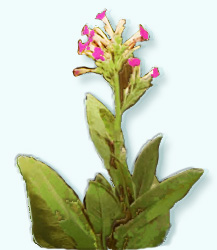 When it is not used in a sacred way, it can be very harmful. Commercial tobacco is a poison containing over 4000 chemicals. The dominant culture exploits tobacco by commercializing and glamorizing cigarette abuse. When tobacco is used as a drug: smoking daily or chewing, it is not being used in a sacred manner. It�s also a problem when young people use it to be cool and fit in even if they don�t have the right. Commercial tobacco was introduced from the outside. When smoking is considered an everyday affair, it looses its power. The addictive nature of it destroys our communities. 40% of all Native Americans smoke. Around the world, 7 people die every minute because they abuse tobacco. Native Americans abuse tobacco at a higher rate than any ethnic group in America. When it is not used in a sacred way, it can be very harmful. Commercial tobacco is a poison containing over 4000 chemicals. The dominant culture exploits tobacco by commercializing and glamorizing cigarette abuse. When tobacco is used as a drug: smoking daily or chewing, it is not being used in a sacred manner. It�s also a problem when young people use it to be cool and fit in even if they don�t have the right. Commercial tobacco was introduced from the outside. When smoking is considered an everyday affair, it looses its power. The addictive nature of it destroys our communities. 40% of all Native Americans smoke. Around the world, 7 people die every minute because they abuse tobacco. Native Americans abuse tobacco at a higher rate than any ethnic group in America.
|
If we abuse a sacred plant, we risk spiritual disconnection. Many Elders feel that any use of tobacco that occurs outside of ceremony is an affront to the Creator. Think about it! Nothing commercially marketed, chemically laced and mass marketed can sacred.
|
Abusive Uses
When a sacred plant is not used in a sacred way, it can be very harmful. Commercial tobacco is a poison containing over 4,000 chemicals. The dominant culture exploits tobacco by commercializing and glamorizing cigarette abuse. When tobacco is used as a drug -- smoking it daily or chewing it; it is not being used in a sacred manner. It�s also a problem when young people use it just to be kewl and to fit in even if they don�t have the right to use it. Commercial tobacco was introduced from the outside. When smoking becomes a habit, a mundane, everyday affair, it looses its power. The addictive nature of it destroys our communities. Around the world, 7 people die every minute because they abuse tobacco. 40% of all our Native people smoke. This is the highest percentage of all groups. That means Native Americans abuse tobacco at a higher rate than any ethnic group in America.
Role Models For Our Youth.
We need to be good role models to our youth. Lawrence Shorty, founder of the Native Tobacco People asks us to "Think about what goes through their minds when they see us holding a cigarette in a bar, drinking and disrespecting women (or ourselves), throwing cigarettes in urinals. What do our youth think when they see this?" We cannot be hypocritical in our actions. We must show our youth that tobacco should only be used in ceremony. Think about where will we be as a people if we lose our spirituality? Our young people must realize that they need to stop abusing tobacco and educate themselves about its spiritual aspects. Tobacco teaches Indian people about themselves. The discipline it teaches and the respect it demands helps and individual grow to be a good person.
Real Tobacco
It is important to remember that Native Tobacco is a different species that is indigenous to the Americas. Real tobacco is not the tobacco you find in smoke shops and stores. When we say tobacco in English we are not talking about a sacred plant. There are over 60 species of this plant. It grows wild in most sections of North America. However, it is no way related to tobacco and does not contain nicotine or other poisonous properties. The Great Lakes Ojibwe, and the neighboring Iroquois used it for a number of medicinal purposes, including as a remedy for stomach aches and fever. It tends to remove obstructions from every part of the system and is even felt to the ends of the toes. Indian Tobacco not only cleanses the stomach but exercises a beneficial influence over every part of the body. Our own native languages have a word for tobacco that is to be used in offerings. We need to address the energy within that plant by its native name so that we can understand the plant as it understands us. It is important to know the name of the plant in your native language
Should We Use Cigarettes To Pray?
Most Native people don�t have access to our real botanicals. We�ve been moved off the lands where these plants were grown. Reservation life encourages peer pressure to smoke commercial tobacco and to rely on products that can be obtained quickly and easily from local stores owned by non-Indians. If the plant is not prepared properly and mindfully, the power of the ceremony will be diluted. For our ceremonies to have their full power, we need to know how the tobacco was procured, grown and harvested to have a whole ceremony.
Growing Tobacco
When we use tobacco properly, we must refer to it by its Native American Name. When tobacco is grown from the earth, you know it is clean. It is good for us to develop our knowledge about the use and growing of tobacco in the old way with guidance from our grandparents and other Native tobacco people. To grow tobacco in a sacred way, we must re-establish the bonds between oneself and the earth, sky, plants, and animals. Traditional, sacred methods should be utilized in preparing the earth and the seeds. We need to revive our planting ceremonies so that we can have access to tobacco that is grown and prepared in a good way for our ceremonies We need to be mindful of the reasons behind why we do things the way we do. Do everything by hand, in a good way. Proper preparation, use of sacred stones in the planting, acknowledge our directions so that we remain mindful our own state of being in creation. Using tobacco traditionally requires a whole different mind set. We need to realize that we are more whole than we give ourselves credit for. We must find the wisdom and the courage to revive our cultural ways.
Tobacco is part of our heritage. We need to better understand our traditions, so we can better understand who we are. Reestablish our belief in tobacco as a sacred plant for healing, ceremony and prayer. Using tobacco traditionally requires a whole different mind set. We need to realize that we are more whole than we give ourselves credit for. We must find the wisdom and the courage to revive our cultural ways. Stop abusing tobacco and make a commitment to learn about its sacred uses. Re-commit to sacred tobacco use and make a distinction between sacred and commercial tobacco. We have our choices. The difference between what is sacred and what isn�t. Like all medicines, when treated with respect, tobacco is helpful. When treated with disrespect, it is dangerous.
|
"Tobacco was seen by our people as a gift from the Creator which would enable us to communicate with him. We were given tobacco because it affected the way we were able to think� We were given knowledge to fashion a pipe with which we could take very small puffs of tobacco smoke. We would only take small puffs, and then we would immediately blow out the smoke because smoke was not meant to be taken into our body and held there. The smoke needed to leave us in order to rise to the Creator with our prayers and thoughts. If we held it in our body, it would be an unnatural presence there. Immediately after taking the puff of smoke, our minds would race, and our whole body would be affected by this smoke since tobacco is a very powerful medicine. It has a specific purpose which must not be abused."
Elder Danny Musqua, Wunska. First Nations Youth Inquiry into Tobacco use: Final Comprehensive Report to Health Canada, [Saskatchewan Indian Federated College, April 1997], p.52).
|
Cedar (Keezhik)
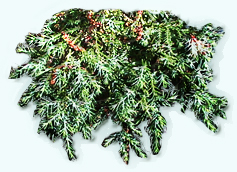 Keezhik (Cedar) represents the Southern direction and the soul. The leaves are cleaned from the stems and separated into small pieces, which are used in many ways. When burned, Keezhik acts as a purifier, cleansing the area in which it is burned and emitting a pleasant scent. True cedar is burnt while praying to the Great Mystery in meditation, and also to bless a house before moving in. Cedar was offered to the fire to smudge the lodge and people. It is also used to waft the smoke to ward away sickness. In traditional medicine, a compound decoction of twigs was made into an herbal steam for rheumatism. It works both as a purifier and as a way to attract GOOD energy in your direction. Elders say put some in you shoes and only goodness will come your way. Many traditional women keep some cedar in their left pocket. When you breathe in the smell of cedar you decide that you're going to have courage and stamina and that you're going to survive. You think of what the herb means, why it was given to us � It's not magic. Keezhik (Cedar) represents the Southern direction and the soul. The leaves are cleaned from the stems and separated into small pieces, which are used in many ways. When burned, Keezhik acts as a purifier, cleansing the area in which it is burned and emitting a pleasant scent. True cedar is burnt while praying to the Great Mystery in meditation, and also to bless a house before moving in. Cedar was offered to the fire to smudge the lodge and people. It is also used to waft the smoke to ward away sickness. In traditional medicine, a compound decoction of twigs was made into an herbal steam for rheumatism. It works both as a purifier and as a way to attract GOOD energy in your direction. Elders say put some in you shoes and only goodness will come your way. Many traditional women keep some cedar in their left pocket. When you breathe in the smell of cedar you decide that you're going to have courage and stamina and that you're going to survive. You think of what the herb means, why it was given to us � It's not magic.
Abuses
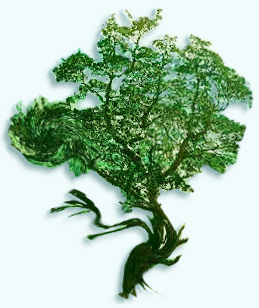 New Age tourists have been abusing the sacred Cedar tree Manido Giizhigance on the Grand Portage Reservation in Minnesota. New Age tourists have been abusing the sacred Cedar tree Manido Giizhigance on the Grand Portage Reservation in Minnesota.
Sage (Sukodawabuk)
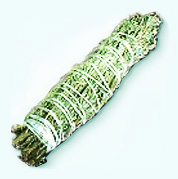 Sukodawabuk, also known as sage, is used in much the same ways as Keezhik (cedar). it is burned as a purifier, but when compared to the "piney" scent of cedar, sage has a spice air. Shkodawabuk represents the Western direction. Sage is used by the original peoples to make their prayers, to signal the creator of one's need for help. There are many varieties of Sage and all are effective in smudging. Smudging is a way of using the smoke from burning herbs to cleanse the body, an object, or a given area of negative influences. Many Native Americans used varieties of sage for medicinal purposes as well as religious ceremonies. The burning of Sage in smudging ceremonies is to drive out evil spirits, negative thoughts and feelings, and to keep negative entities away. The root was used by the Ojibwa in three ways: as an anti-convulsive, on wounds to stop bleeding, and as a stimulant. The Potawatomi burned the plant to smudge and also used it as poultice on long-standing sores. Sukodawabuk, also known as sage, is used in much the same ways as Keezhik (cedar). it is burned as a purifier, but when compared to the "piney" scent of cedar, sage has a spice air. Shkodawabuk represents the Western direction. Sage is used by the original peoples to make their prayers, to signal the creator of one's need for help. There are many varieties of Sage and all are effective in smudging. Smudging is a way of using the smoke from burning herbs to cleanse the body, an object, or a given area of negative influences. Many Native Americans used varieties of sage for medicinal purposes as well as religious ceremonies. The burning of Sage in smudging ceremonies is to drive out evil spirits, negative thoughts and feelings, and to keep negative entities away. The root was used by the Ojibwa in three ways: as an anti-convulsive, on wounds to stop bleeding, and as a stimulant. The Potawatomi burned the plant to smudge and also used it as poultice on long-standing sores.
Abuses
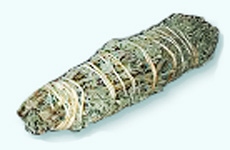 The New Age is often guilty of abusing this sacred plant. Many use it out of ignorance for every occasion without any real understanding about its power. It�s not appropriate or respectful to over-use it. A lot of health food stores are selling sweet grass and sage as "NDN incense". What they are doing is wrong! Don't give these places your money. Don�t promote bad behavior. Never buy "smudge stix" from food co-ops or from anywhere that you can�t be sure the herb wasn�t treated respectfully from seedling to harvest. Sage that is grown commercially has no power. We must stop skipping steps and taking short cuts. Smudge isn�t just incense � to use it as nothing more than atmosphere for new age cocktail parties is disrespectful and will only bring harm to those who do so. It won�t chase away ghosts, help you see what color someone�s aura is and it is not intended to "cleanse crystals". Many New Agers think of "smudge stix" as magic objects. Their thinking is wrong and immature. Sage is a tool that helps us get to a point. Plastic Shamans who don't know how to use sage properly and respectfully can do great harm to you. Only those who are well-grounded in Native American traditional values should ever even attempt to use this herb in a sacred way. The New Age is often guilty of abusing this sacred plant. Many use it out of ignorance for every occasion without any real understanding about its power. It�s not appropriate or respectful to over-use it. A lot of health food stores are selling sweet grass and sage as "NDN incense". What they are doing is wrong! Don't give these places your money. Don�t promote bad behavior. Never buy "smudge stix" from food co-ops or from anywhere that you can�t be sure the herb wasn�t treated respectfully from seedling to harvest. Sage that is grown commercially has no power. We must stop skipping steps and taking short cuts. Smudge isn�t just incense � to use it as nothing more than atmosphere for new age cocktail parties is disrespectful and will only bring harm to those who do so. It won�t chase away ghosts, help you see what color someone�s aura is and it is not intended to "cleanse crystals". Many New Agers think of "smudge stix" as magic objects. Their thinking is wrong and immature. Sage is a tool that helps us get to a point. Plastic Shamans who don't know how to use sage properly and respectfully can do great harm to you. Only those who are well-grounded in Native American traditional values should ever even attempt to use this herb in a sacred way.
|
"As my mother taught me, and she was taught, the plants, animals, birds � everything on this earth � they are our relatives, and we had better know how to act around them or they will get after us."
-- Kathleen Rose Smith Mihilakawana Pomo/Olemitcha Miwok
|
Sweet Grass (Weengush)
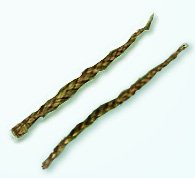 Weengush, or Sweet grass is used to cleanse the mind, body and spirit. It is considered sacred because it is symbolic of purification. It represents the Northern direction and the body. The elders tell us that scent of these natural herbs is pleasing to the creator and will incline him to hear the ceremony with favor. The smoke is considered distasteful to all evil beings and thwarts their powers. This plant plays an important part in ceremonies of spiritual significance. When Weengush is used in ceremony, each person is to fan the sweet grass smoke, first to their heart, second to their mind, third around their body and lastly, return the smoke to their heart. The prayer said during this process is: "Great Mystery, please cleanse me of my negativity and fill me with the positive energies of love, so that, as I am healed so may I work for the healing of our Earth Mother." Weengush, or Sweet grass is used to cleanse the mind, body and spirit. It is considered sacred because it is symbolic of purification. It represents the Northern direction and the body. The elders tell us that scent of these natural herbs is pleasing to the creator and will incline him to hear the ceremony with favor. The smoke is considered distasteful to all evil beings and thwarts their powers. This plant plays an important part in ceremonies of spiritual significance. When Weengush is used in ceremony, each person is to fan the sweet grass smoke, first to their heart, second to their mind, third around their body and lastly, return the smoke to their heart. The prayer said during this process is: "Great Mystery, please cleanse me of my negativity and fill me with the positive energies of love, so that, as I am healed so may I work for the healing of our Earth Mother."
Because it signifies the hair of Nokimis Akiin (Our Grandmother the Earth) it is usually braided. Each of the three sections that go into the braid have a specific meaning, being mind, body and spirit. Because the Anishnaabe people live life in a very sacred manner, when taking something from the Earth, they always explain to the spirit of the plant why it is being done and offer some tobacco in return for the generosity and help of the plant which shared itself so freely.
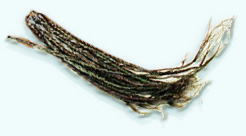 Many sacred and cultural objects re made with Weengush. The Men�s grass dance outfits are symbolic of the sacred plant. A braid of sweet grass was traditionally tied to the dancers' belts. The colorful yarn or fringe that sways from their regalia symbolizes sweet grass swaying in the wind. Weengush is also used to make coiled baskets, called unity baskets. These Unity baskets are not for sale. It is said that in the old days very small ones kept children's navel cords. Sweet grass is a very powerful herb. Many sacred and cultural objects re made with Weengush. The Men�s grass dance outfits are symbolic of the sacred plant. A braid of sweet grass was traditionally tied to the dancers' belts. The colorful yarn or fringe that sways from their regalia symbolizes sweet grass swaying in the wind. Weengush is also used to make coiled baskets, called unity baskets. These Unity baskets are not for sale. It is said that in the old days very small ones kept children's navel cords. Sweet grass is a very powerful herb.
Unity
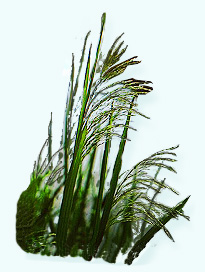 The elders tell us that "Sweet Grass is the hair of our Mother, each strand alone is not as strong as when braided together." The braid represents to us the great strength a united tribe has opposed to a divided one. The elders tell us that "Sweet Grass is the hair of our Mother, each strand alone is not as strong as when braided together." The braid represents to us the great strength a united tribe has opposed to a divided one.
Abuses
Alot of New Age businesses have been harvesting sweet grass for commercial use. They have no respect and they pull it out by the roots and at the wrong times of the year so that the plant cannot grow back. When harvesting medicines, a traditional NDN shows respect by never taking more than 1 /10 of what�s there. Medicine is only taken at certain times of the year and tobacco is always given back in gratitude. No one should buy sweet grass unless they are absolutely sure that the earth hasn�t been "strip-mined" to get it. Collecting medicines is a long complicated process. It mustn't be done haphazardly for commercial profit. Great care must be taken in harvesting by an elder who understands the plant and can develop a relationship with it. This cannot be done as quickly and efficiently as most consumers would like. The roots of a sweet grass plant are very fragile and can be easily uprooted in the harvesting of the grass. There are places in the Northeast where sweet grass can no longer grow because it was not harvested in a good way by hundreds New Agers. If you don�t know for sure that care was taken gathering sweet grass, don�t buy it. The herb should always be treated with respect and dignity. New Age practices such as selling sweet grass Christmas wreaths is sacrilegious. Don't support it.
Think about it. Our sacred Weengush represents the hair of Nokimis Akiin! Do you really want anything to do with hair that�s pulled out from the roots?
We must always remember that the ends don�t justify the means. Some of these New Age seekers are overly concerned about where they can buy sacred objects. They don't understand that the object isn�t sacred. Only sacred plant is addressed in a Native language, by an elder who is entitled to do so, does it become sacred. NDNS and nonNDNS alike need to learn that they must pay attention to the whole process! It must have integrity! The planting, the harvesting, the giving back. One of our grandmas has a warning for the New Age seekers. She says, "It�s almost always a bad idea to try to buy "sacred objects". The person doing this should be asking themselves why they need to do this and deal with that shortcoming first."
Gratitude
Our sacred plants have a special role to play in our lives. We need to keep the idea of gratitude ever present in our mind. We cannot keep our NDN worldview alive without fully appreciating the concept of gratitude. Proper use of our sacred plants helps us to convey the meaning of gratitude. Whenever we take something, we must remember to give. We must be able to be grateful before receiving. To appreciate that life is a gift and that everything that comes with it � our successes and our defeats -- is truly a gift in itself. Tobacco is what is offered back to Nokimis Akiin - grandmother earth. When we find a feather or collect medicines, we take them with us as a gift from her. We offer tobacco. When we hunt animals, we offer tobacco to the earth and to the chief spirit (Manitou) of the plant or animal we're asking to give of itself. We also offer tobacco when we cross a river, before thunderstorms when someone dies, when we see an eagle. This idea of gratitude is what binds us together as native people and keeps us strong. The four sacred herbs complete the cycle of life. Their smoke is used to cleanse the mind, spirit, body and soul. They can remove negative forces and refresh us.
|
To achieve honesty within yourself; to recognize who and what you are.
Do this and you can be honest with all others.
|
|
